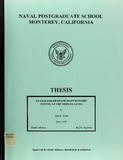Report of NPSAT1 battery thermal contact resistance testing, modeling and simulation
| dc.contributor.author | Sakoda, Daniel | |
| dc.contributor.author | Phelps, Ronald | |
| dc.contributor.author | Donovan, Bryce | |
| dc.date.accessioned | 2012-10-30T15:01:31Z | |
| dc.date.available | 2012-10-30T15:01:31Z | |
| dc.date.issued | 2012-10 | |
| dc.identifier.uri | https://hdl.handle.net/10945/14843 | |
| dc.description | The report entitled “Report of NPSAT1 Battery Thermal Contact Resistance Testing, Modeling and Simulation” was prepared for the Naval Postgraduate School Space Systems Academic Group. | en_US |
| dc.description.abstract | Thermal modeling is an important part of spacecraft design, especially where critical components have narrow operating temperature limits. For the Naval Postgraduate School’s NPSAT1 spacecraft, the lithium ion battery is the spacecraft component with the smallest temperature range of 0°C to 45°C during operation. Thermal analysis results, however, can only provide adequate results if there is sufficient fidelity in thermal modeling. Arguably, the values used in defining thermal coupling for components are the most difficult to estimate because of the many variables that define them. This document describes the work performed by the authors starting in the 2012 winter quarter as part of the SS3900 directed study course. The objectives of the study were to determine an adequate thermal model of the NPSAT1 battery as a lumped capacitance model, and an appropriate value of thermal resistance between the battery and its mounting surface for three thermal interfaces: metal-to-metal (bolted interface), Kapton®, and Chotherm® 1671. These objectives were performed through testing in a thermal-vacuum chamber with controlled boundary conditions. Modeling and simulation using the NX I-DEAS Thermal Model Generator software was performed to duplicate the test results in simulation. Agreement between the simulations and testing was achieved with differences ranging between +4°C and -8°C for the metal-to-metal interface, to as low as +2°C to -1°C using an elastomeric thermal interface material (Chotherm® 1671). The test-validated thermal model can then be incorporated into the larger NPSAT1 thermal model tospecifically evaluate battery temperatures for various flight operations. | en_US |
| dc.description.sponsorship | Space Systems Academic Group (SSAG) | en_US |
| dc.format.extent | x, 25 p. : col. ill.; 28 cm. | en_US |
| dc.language.iso | en_US | |
| dc.publisher | Monterey, California. Naval Postgraduate School | en_US |
| dc.rights | This publication is a work of the U.S. Government as defined in Title 17, United States Code, Section 101. Copyright protection is not available for this work in the United States. | en_US |
| dc.subject | NPSAT1 | en_US |
| dc.subject | Small Satellite | en_US |
| dc.subject | Thermal-Vacuum Testing | en_US |
| dc.subject | Thermal Modeling | en_US |
| dc.subject | Lumped Capacitance | en_US |
| dc.subject | Lithium-ion Battery | en_US |
| dc.title | Report of NPSAT1 battery thermal contact resistance testing, modeling and simulation | en_US |
| dc.type | Technical Report | en_US |
| dc.contributor.corporate | Naval Postgraduate School (U.S.) | |
| dc.contributor.department | Electrical Engineering | |
| dc.identifier.npsreport | NPS-SP-12-002 |
Files in this item
This item appears in the following Collection(s)
-
All Technical Reports Collection
Includes reports from all departments. -
Faculty and Researchers' Publications
-
Space Systems (NPS-SP)





